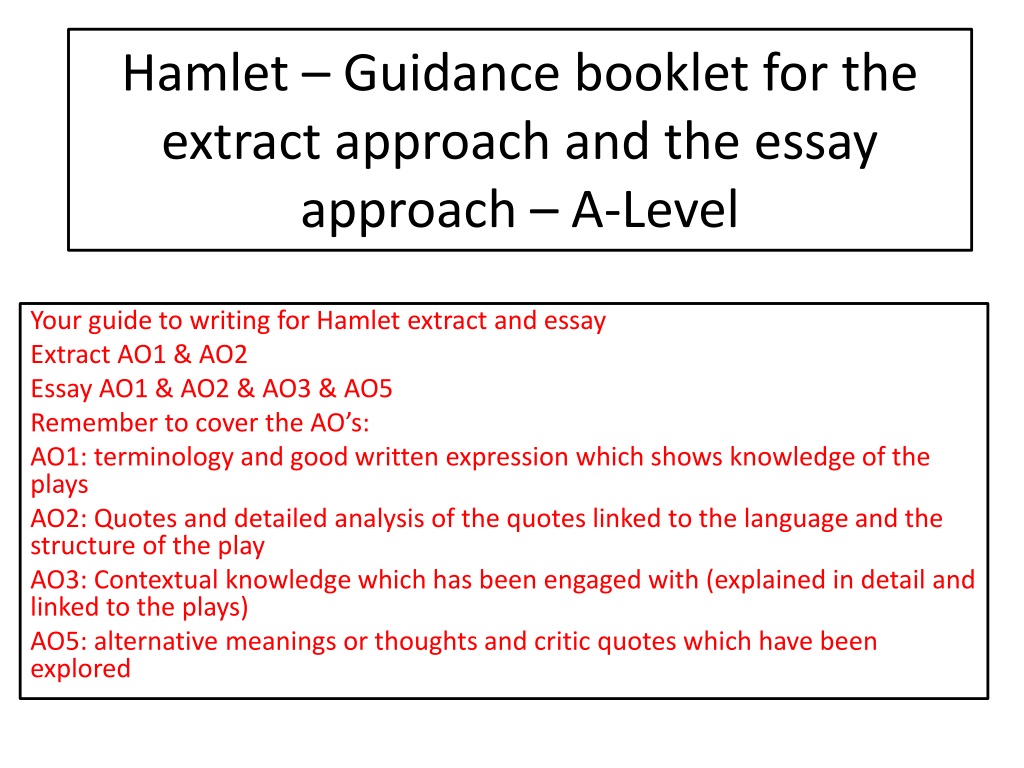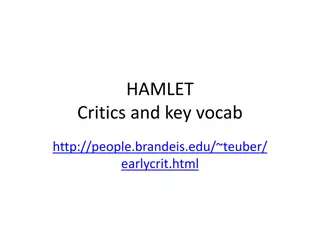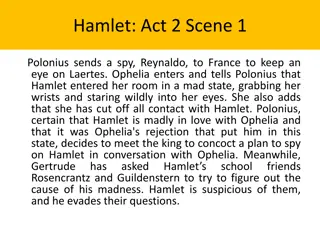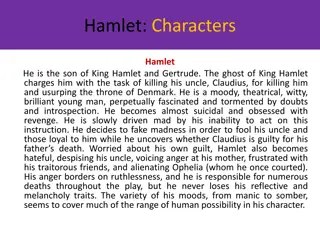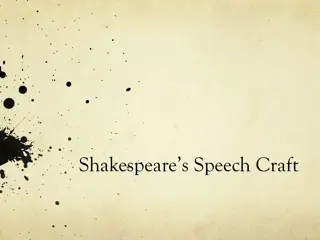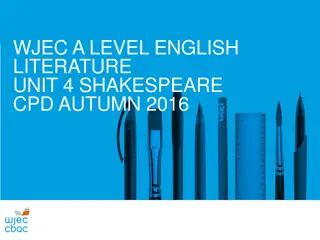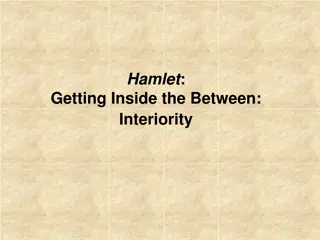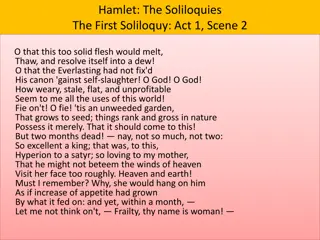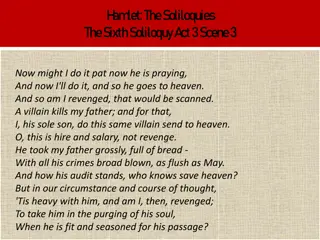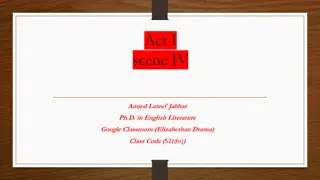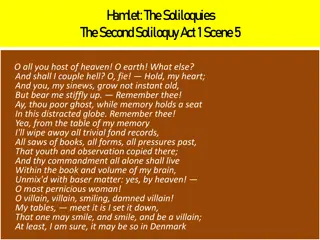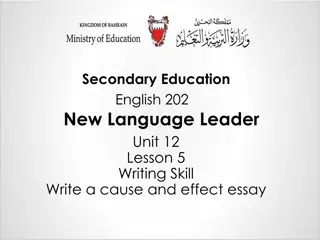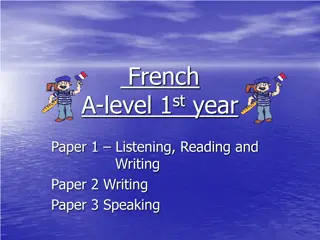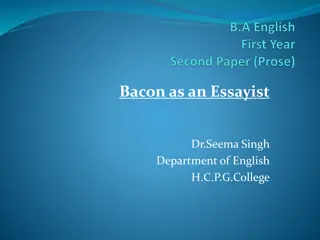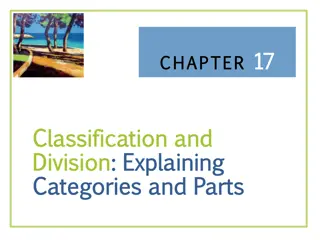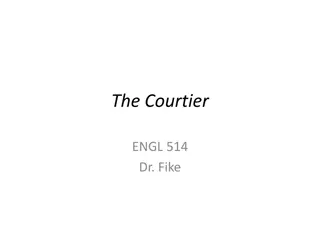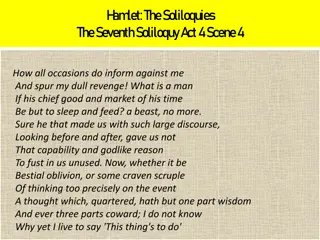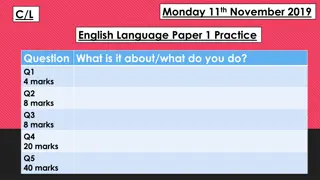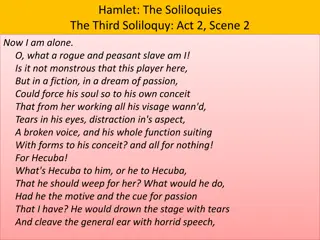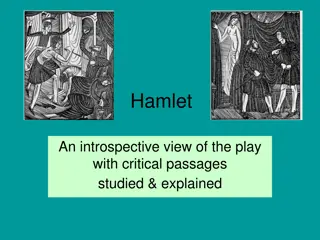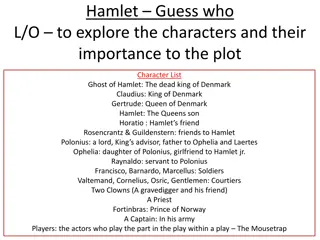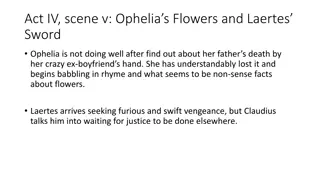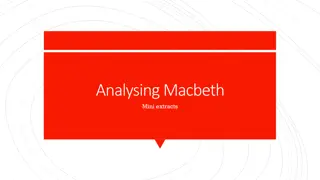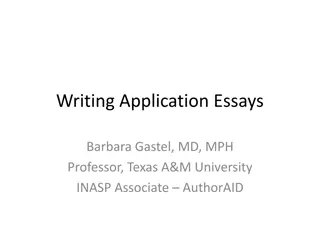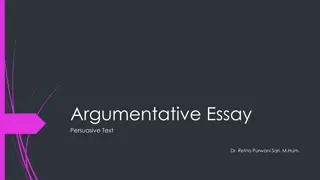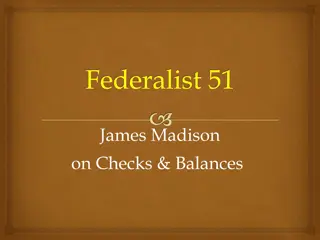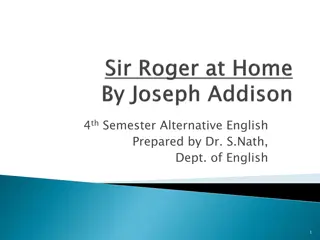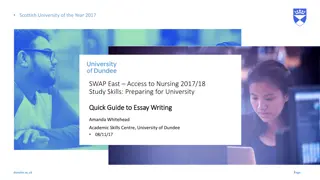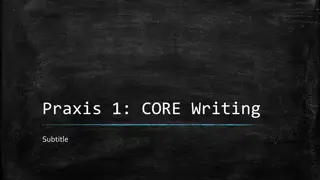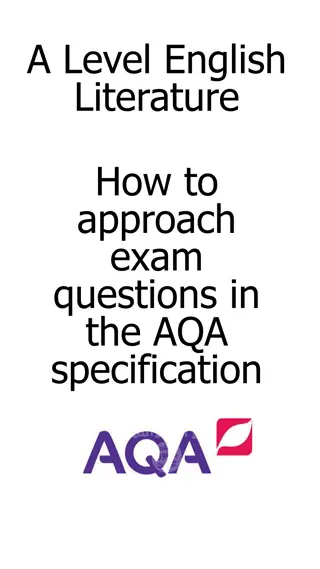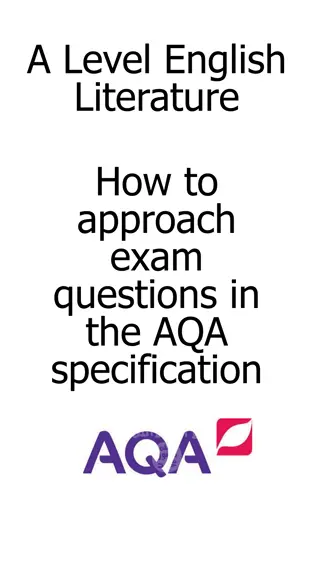Comprehensive Guide for Writing Hamlet Extracts and Essays at A-Level
Your essential companion for excelling in Hamlet extract and essay writing at A-Level. This comprehensive guide covers AO1, AO2, AO3, and AO5 requirements, providing strategies for analyzing extracts, learning quotes and context, tackling extract and essay questions effectively, and incorporating critical interpretations. Enhance your understanding of Hamlet with practical tips and methods outlined in this resource.
Download Presentation

Please find below an Image/Link to download the presentation.
The content on the website is provided AS IS for your information and personal use only. It may not be sold, licensed, or shared on other websites without obtaining consent from the author. Download presentation by click this link. If you encounter any issues during the download, it is possible that the publisher has removed the file from their server.
E N D
Presentation Transcript
Hamlet Guidance booklet for the extract approach and the essay approach A-Level Your guide to writing for Hamlet extract and essay Extract AO1 & AO2 Essay AO1 & AO2 & AO3 & AO5 Remember to cover the AO s: AO1: terminology and good written expression which shows knowledge of the plays AO2: Quotes and detailed analysis of the quotes linked to the language and the structure of the play AO3: Contextual knowledge which has been engaged with (explained in detail and linked to the plays) AO5: alternative meanings or thoughts and critic quotes which have been explored
Learning Quotes & Context & Critics: Flashcards Quizlet Memory Memorise (loads already on there) Post it notes Look, cover, say, check repeat Write them out and create quizzes Choose general quotes which cover more than one theme Re-read the play and highlight key quotes Record yourself saying the quotes/context/critics & listen back to it. Podcast yourself & others discussing the play
Extract Questions Marks AO1 5, AO2 - 10 Use the extract booklet that accompanies this guide With close reference to language and imagery explore what the character or theme reveals in the extract. Your close analysis should focus on dramatic techniques used by Shakespeare, as well as the language and the imagery in the extract. You should cover quotes from across the extract and remember you are only writing the extract analysis for 15 marks and 15 20 minutes, so you want to be as concise as possible, while still exploring nuances of meaning.
Essay Questions Marks AO1 5, AO2 10, AO3 20, AO4 10 Use the NEXT slide for challenging essay questions Cautionary Advice AO3 for 20 marks suggests that the context is hugely important, however do remember that the context should be embedded to support the analysis (don t make this a purely historical context essay please), but do ensure that context is clearly embedded and signposted to the examiner. With reference to events that spread across the play and from memory using quotes/moments/events explore the way Shakespeare has presented the idea in the question. Your analysis should focus on dramatic techniques used by Shakespeare, as well as the language and the imagery in the play. You should cover quotes from across the whole play choosing 3 or 4 key events to discuss and remember you are writing the essay analysis for 40 45 minutes and 45 marks.(AO1 and AO2) You must include contextual knowledge that is embedded within the essay analysis (AO3) You must include critical interpretations and alternative readings (AO5)
Challenging Essay Question: underline or highlight the imperative information in the question In his presentation of royalty in Hamlet, Shakespeare could be accused of undermining the political and social values of his time. Explore this view of Hamlet Despite his resolutions to act purposefully, Hamlet seems always to be at the mercy of chance. Discuss the dramatic importance of chance and accident in Hamlet Through a detailed study of Hamlet discuss the presentation of the theme of loyalty in the play. The play is, above all, a sustained exploration of the differences between how things seem and how they really are. Discuss this view of Hamlet. Through a detailed study of Hamlet, discuss the ways tragedies do or do not reassure audiences that good can triumph over evil. In Hamlet, it is hard to decide whether Shakespeare s interests lie primarily with the personal or political dimensions of his subject. Explore this point of view. Discuss Shakespeare s presentation of pretence and hypocrisy in Hamlet. Questions about Hamlet s sanity are a distraction; mad or sane he is the same tragic hero. Consider Shakespeare s presentation of Hamlet s madness in the light of this remark. Through a detailed study of Hamlet, examine the dramatic importance of ugly behaviour and horrifying events.
Important terms used by Shakespeare Dramatic irony: irony that is inherent in speeches or a situation of a drama and is understood by the audience but not grasped by the characters in the play. Irony: the use of words to convey a meaning that is the opposite of its literal meaning. Pathos: the quality or power in an actual life experience or in literature, music, speech, or other forms of expression, of evoking a feeling of pity, or of sympathetic and kindly sorrow or compassion. Revenge tragedy: drama in which the dominant motive is revenge for a real or imagined injury; it was a favourite form of English tragedy in the Elizabethan and Jacobean eras and found its highest expression in Hamlet. Set piece: a scene which would stand alone outside of the play. Soliloquy: an utterance or discourse by a person who is talking to himself or herself or is disregardful of or oblivious to any hearers present (often used as a device in drama to disclose a character's innermost thoughts): Hamlet's soliloquy begins with To be or not to be. . 2. the act of talking while or as if alone. Tableau: a symbolic arrangement of characters on stage. Blank Verse: unrhymed verse, especially the unrhymed iambic pentameter
Structure of the play Act 1 Scene 1 etc. Use of soliloquy Stage directions Meta theatricality Play within a play The events placement within the play Action happening offstage
Analysis paragraphs: rough guide Link to question Event from the play (& where it happens) Evidence from the play (can be interlinked from across the play) Analyse: Explain effect, alternative meaning and critic explorations and or context information relevant to your analysis, connotations/zoomed in words, links to language and structure terminology/dramatic techniques/stagecraft and Shakespeare s intentions, readers reactions (at the time of staging and can have a modern focus) Link to context / critics and analyse how this is important must be embedded
Critics Quotes on Hamlet To kill in revenge is to sink to the same moral level as the killer. Hamlet delays because he is resisting his own moral disintegration 'The past has to be forgotten if it is not to become the gravedigger of the present' Nietzsche The incompatible value systems of the Roman and Christian codes of honour come into direct conflict The Ghost/Father is insistent on revenge (Roman), but also talks about punishment after death(Christian).. Little wonder Hamlet delays.. Hamlet is distracted by contrasting nature of his desires and overwhelmed by the magnitude of his own purposes Dr Johnson Coleridge and Romanticism view they loved the play s focus on the self which guided the audience to ponder and grow intellectually- Hamlet was a man whose intellectual energy and alertness understandably made action impossible The number of images of sickness, disease.. the idea of an ulcer or tumour, as descriptive of the unwholesome condition of Denmark morally Spurgeon "With the strongest purposes of revenge Hamlet is irresolute and inactive; amidst the gloom of the deepest melancholy he is gay and jocular; and while he is described as a passionate lover he seems indifferent about the object of his affections." McKenzie- series of contradictions Hamlet broke many rules one being the rule of action over character McCary talking about how Shakepeare did not care about focusing on characters internal struggles almost more than the plot and action.
Hamlet - Monarchy Situation of the time Context points A04 Earlier in her reign, it was a time of great instability, plotting and sub-plots behind the scenes. Elizabeth had fought off plots throughout her reign years earlier from Catholics attempting to instate cousin Mary Stuart, and different Popes had ex- communicated her for her rejection of Catholicism, then said it would be no sin to invade England! A nervous country! Who s there? Opening line of Hamlet! At the time of writing Hamlet, Shakespeare would have been part of a whole national mood of fear as to who would come next after Elizabeth as the Tudor reign was due to end. The danger of marrying unwisely for Gertrude could be linked to the same potential problem for Elizabeth I the Virgin queen If she married a European prince, England may well have become lost to foreign control (an obvious huge concern and paranoia of the English people! ) whilst if she remained childless, the threat of civil war may break out. Behind the scenes, James I was plotting to try and overcome the Henry VIII decree that no-one of the house of Stuart acceded to the throne.Kurland: The whole play is informed by the uncertainty engendered by James manoeuvres and threats to secure the English succession. One plotter -Earl of Essex, and advisor and possible one time younger romantic interest, thought he could take advantage of the increasingly frail and arguably senile queen. He was disrespectful in her later years (turning his back on Elizabeth I once, only to be smacked in the back of his head!) and assisted James but got carried away and led an early rebellion in 1601, leading to his execution. Declared mad on the scaffold part of reason for acting in such a way links to Hamlet s task of overthrowing a king is at the heart of his madness plot or genuine madness. Elizabeth s virginity and the cult of poetry Spenser s The Fairie queen , etc, may be linked to Hamlet s repulsion by perceived wrong sexual behaviour of Gertrude by Hamlet. Also Ophelia and the damaging impact on her of Hamlet s madness and spies like Polonius may be linked to the way Elizabeth was treated towards the end of her reign.
Hamlet Monarchy at the time contd (AO4) I have the body of a weak and feeble woman but the heart of a king Elizabeth s acknowledgement of the patriarchal structure / feeling of the time. Gertrude s impossible position after the death of her husband? Gertrude s forced silence may be linked to the way Elizabeth did not speak and agree I observe and remain silent her diplomacy / determinaion to tread a moderate religious path and not jump into things easily wise! Hamlet s repulsion by Gertrude may be linked to Shakespeare and the country s concern over an aging sexual monarch who wore an open dress in one account wrinkly bosom She was a mother to the country, but no longer able to be a realistic lover. (68 at the time Hamlet was first performed)This problem with reconciling the mother and lover figure may lie at the root of Hamlet s attack on Gertrude. Hugely popular queen strong, moderate protestant queen encouraged the arts was popular with Shakespeare - her death heralded a time of great mourning perhaps Hamlet s repulsion at how quickly Claudius and Gertrude move on show how this would have been hugely shocking to forget about a popular monarch like Elizabeth or (Old King Hamlet) in this way. Corruption Elizabeth bestowed privileges on a chosen few sycophantic advisers in later years leading to furious rivalry at court. Link to Claudius treatment of Laertes / Polonius / Rosencrantz and Guildenstern
